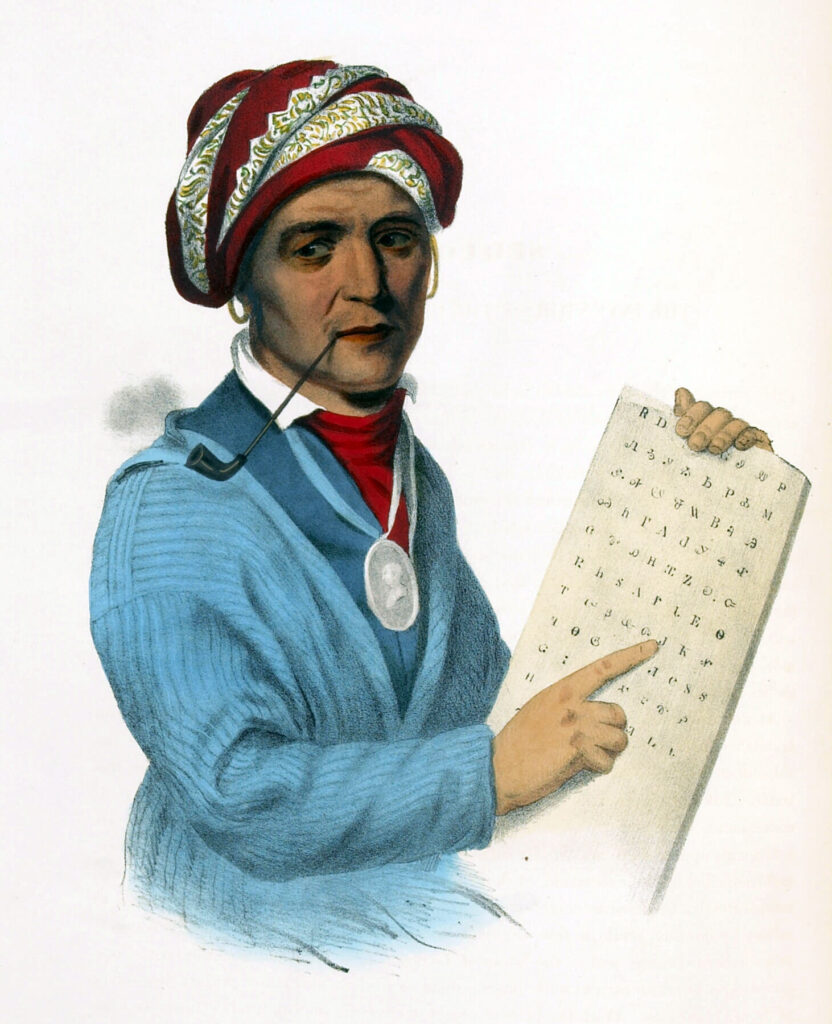In a world where written language is commonplace, it’s easy to forget the profound impact of developing a writing system. One of the most extraordinary stories in this arena is that of Sequoyah and the creation of the Cherokee syllabary. As we delve into this tale, we’ll discover a profound journey of innovation, cultural preservation, and a bridge between disparate societies in the early 19th century.
Who was Sequoyah?
Before embarking on the main journey, we need to understand the man behind the story – Sequoyah. Born around 1770 near Tuskegee, Tennessee, Sequoyah was a Cherokee silversmith. In contrast to the popular belief of the time, Sequoyah was monolingual, only speaking the Cherokee language.
Interestingly, Sequoyah was not his original name. He was born with the name Sikwayi (or Sogwali), meaning ‘Pig’s Foot’, a moniker that reflected his physical disability. The name ‘Sequoyah’, akin to the Latin rendering of the Cherokee name, became more popularly associated with him after his considerable achievements.

The Inspiration
Sequoyah became intrigued by the ‘talking leaves’ of the European settlers, as the written word seemed magical to the Cherokee people, who had no such system. He recognized the power of the written word and how it contributed significantly to the white settlers’ progress. The literate had an ability to convey ideas, messages, and information across distances and time, which to the Cherokee, seemed almost supernatural.
Sequoyah served in the U.S. Army during the War of 1812, where he was further exposed to written communication, fueling his interest. He began to understand the relationship between spoken sounds and written symbols, even though he could not comprehend the content of the English written word. Inspired by these revelations, Sequoyah embarked on a journey to develop a writing system for his people, believing it would help the Cherokee Nation resist white encroachment on their lands.
A Journey of Tenacity and Innovation
Sequoyah began his ambitious project around 1809, initially attempting to create a character for each word in the Cherokee language. However, this system soon proved too unwieldy due to the vast number of words. He then tried to break down the language into smaller components, akin to the letters in the English alphabet, but this too was unmanageable as Cherokee, a polysynthetic language, has a complex phonetic structure.
Eventually, he settled on a syllabary system – a set of written symbols representing syllables, which could combine to form words. It was a massive undertaking. The Cherokee language is rich with distinct syllables, and Sequoyah had to create a unique character for each. Over several years, through a process of trial and error, Sequoyah devised 86 symbols to represent all the syllables in the Cherokee language.
Sequoyah’s daughter, Ayoka, was a crucial companion in this endeavor. She helped her father test the symbols and refine the system. Despite this collaboration, many Cherokee people were skeptical of Sequoyah’s mission. Some viewed it as witchcraft, while others saw it as a fruitless endeavor.
The Breakthrough
Despite the opposition and skepticism, Sequoyah remained undeterred. By 1821, after twelve years of relentless work, he finally perfected his syllabary. To prove its efficacy, he performed a demonstration. He had a man write a message in Cherokee, which was then taken to his daughter in a different location. Ayoka read out the message accurately, convincing the onlookers of the syllabary’s practicality.
News of the Cherokee writing system spread rapidly. Within just a few months, thousands of Cherokee people had become literate. The literacy rate among the Cherokee skyrocketed, eventually surpassing that of the surrounding white settlers. The speed and eagerness with which the Cherokee adopted the syllabary is a testament to its efficiency and Sequoyah’s ingenuity.

Impact and Legacy
The syllabary was more than a means of communication; it became a potent tool for cultural preservation and progress. The Cherokee Nation quickly incorporated it into their societal institutions. By 1825, they were publishing laws in Cherokee using the syllabary. In 1828, they launched a bilingual Cherokee-English newspaper, the Cherokee Phoenix, which was distributed nationally, amplifying their voices on a wider platform.
Moreover, the syllabary played a crucial role in the Cherokee’s resistance against the forced removals by the U.S. government. Although they ultimately faced the infamous ‘Trail of Tears,’ their written language enabled them to record their stories, preserving their culture and history amidst adversity.
Sequoyah’s story is remarkable for many reasons. Here was a man who, despite not being able to read or write in any language, created a new writing system that was rapidly and enthusiastically adopted by his people. He didn’t just create a syllabary; he forged a tool that allowed an entire nation to preserve its culture, resist oppression, and engage with the world.
The legacy of the Cherokee syllabary continues today. It’s still in use, with modern technology adapting it for digital platforms. From the depths of history, Sequoyah’s story continues to inspire us – reminding us of the extraordinary power of language and the profound impact one determined individual can make.








